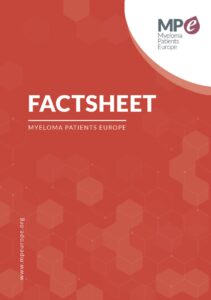What is panobinostat (Farydak®)?
Panobinostat is a cancer medicine that was approved in Europe in 2015 in combination with bortezomib and dexamethasone (an immunomodulatory medicine) for the treatment of relapsed myeloma in adult patients following a third relapse, provided that patients have had at least two previous cycles of treatment, including bortezomib and an immunomodulatory drug.
As myeloma is considered a ‘rare disease’ because of the small number of patients with this disease, panobinostat was granted ‘orphan drug designation’ by the European Commission in 2012. An orphan drug designation is a status assigned to medicines developed for rare disease conditions that affect fewer than 5 patients per 10,000 inhabitants in the EU.
How does panobinostat work?
Panobinostat targets enzymes known as histone deacetylases or HDACs, which are involved in turning genes ‘on’ and ‘off’ within cells. Genes are defined as the coding which our body uses to produce proteins and therefore function. By turning off HDACs panobinostat may slow over-development of plasma cells in myeloma patients or cause these cells to die. The decrease of plasma cells may result in remission of the disease or, at least, may slow its progression. It is the first HDAC inhibitor to be approved for treating myeloma.
What are the benefits of panobinostat?
The approval was based on results from one main study involving 768 previously treated patients with myeloma. Patients were randomly assigned to receive a combination of panobinostat, bortezomib and dexamethasone, or placebo plus bortezomib and dexamethasone alone.
When results were analysed just for the group of patients who had received at least two previous treatments, including bortezomib and an immunomodulatory medicine (thalidomide, lenalidomide or pomalidomide), the average time until the myeloma got worse (progression-free survival) was 12.5 months with panobinostat, versus 4.7 months with placebo.
What are the side-effects with panobinostat?
The most common side-effects1 of panobinostat (which may affect more than 1 in 10 people) are:
- diarrhoea
- tiredness
- nausea (feeling sick)
- vomiting
- weakness
- pneumonia (lung infection)
- tachycardia (increased heart rate)
- palpitations
- irregular heart rhythms
You may also develop the following blood abnormalities:
- thrombocytopenia (low levels of platelets)
- lymphopenia (low levels of certain white blood cells)
- anaemia (low red blood cell counts)
How and when is panobinostat given?
Panobinostat must not be given to women who are breastfeeding. Panobinostat is available as capsules (10, 15 and 20mg). The recommended starting dose is 20mg. Panobinostat is given in 21-day treatment cycles. The capsules should be taken on days 1, 3, 5, 8, 10 and 12 of the cycle. They should be swallowed whole with water, with or without food. Patients should continue panobinostat for eight cycles, after which it is recommended that patients showing clinical benefit continue the treatment for a further eight additional cycles.
Patients should be closely monitored during treatment. If there are severe side-effects, treatment may need to be stopped or the dose reduced. Patients aged over 65 may require more frequent monitoring. Patients who should not take a replacement dose but should wait until the next scheduled dose. They should contact their doctor immediately if they experience any adverse reactions.
References
- European Medicines Agency. Farydak (panobinostat) European public assessment report (EPAR) – lay summary 2015 https://www.ema.europa.eu/en/documents/overview/farydak-epar-summary-public_en.pdf– last updated in 08/2015
- Manufacturer’s product information
- http://www.farydak.com/
- San Miguel JF et al Panobinostat plus bortezomib and dexamethasone versus placebo plus bortezomib and dexamethasone in patients with relapsed or relapsed and refractory multiple myeloma: a multicentre, randomised, double-blind phase 3 trial, Lancet Oncol 2014; 15: 1195–206
- Rajkumar SV Panobinostat for the treatment of multiple myeloma. Lancet Oncol 2014; S1470-2045(14)70443-7
- Rajkumar, SV and Kumar, S. Multiple Myeloma: diagnosis and treatment. Mayo Clin Proc 2016;91(1):101-119
